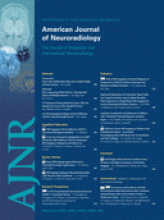In patients with multiple sclerosis (MS), the term dirty-appearing white matter (DAWM) refers to brain regions of intermediate signal intensity between those of focal lesions and normal-appearing white matter (NAWM) on T2-weighted and proton attenuation–weighted images.1–4 Such an abnormality tends to affect more frequently the deep WM, especially that around the ventricles. Defining the extent of DAWM is, however, a challenging task, because signal intensity changes associated with it are difficult to clearly separate from those of the surrounding tissues. As a consequence, DAWM abnormalities have been disregarded by most MR imaging studies of MS.
The pathology of MS lesions has been studied extensively, and it has been shown that focal areas of increased signal intensity on T2-weighted images are characterized by the presence of heterogeneous substrates, including edema, inflammation, demyelination, remyelination, gliosis, and axonal loss.5,6 In contrast, the pathologic substrates of DAWM abnormalities have been investigated only recently.1,4 Moore et al1 demonstrated a loss of myelin phospholipids as well as axonal reduction whose extents are intermediate between those of discrete lesions and NAWM. In a similar setting, Seewann et al4 detected axonal loss, reduced myelin attenuation, and chronic fibrillary gliosis in the DAWM of 10 patients with chronic MS. It is intriguing to note that the chronic nature of the process occurring in the DAWM was supported by the absence of acute axonal pathologic features, remyelination, and blood-brain barrier leakage. These findings support the notion that DAWM pathology might result from a secondary degenerative process remote from focal lesions. However, other seminal MR studies2,3 suggested that DAWM abnormalities may represent early microscopic lesions that have the potential to evolve subsequently to discrete T2-visible changes. If this is the case, the use of high-field strength magnets should have allowed the detection of such tiny lesions, but a study conducted at 4.7T was unable to resolve focal abnormalities in the DAWM of patients with MS.4
During the past 2 decades, the application of quantitative MR-based techniques has partially contributed to overcome the inability of conventional MR imaging measures to quantify the extent and to define the nature of MS tissue damage. These techniques, including T1 and T2 relaxation times (RT), magnetization transfer (MT) MR imaging, diffusion tensor MR imaging, and proton MR spectroscopy, allow us not only to grade the severity of damage in macroscopic T2-visible lesions, but also to detect and grade subtle damage in regions with normal signal intensity on conventional dual-echo scans. At present, only a few studies have applied such techniques to try to define the in vivo MR correlates of DAWM in patients with MS.2–4 These studies have demonstrated consistently that DAWM abnormalities are somewhat in between those measured in macroscopic T2-visible lesions and those seen in the NAWM, in T1 and T2 RT,4 fractional anisotropy (FA),4 and MT ratio (MTR).2,3 So far, there has been no attempt to define DAWM features in patients with MS with a multiparametric, quantitative MR imaging approach.
Against this background, the study by Vrenken et al,7 published in the current issue of the American Journal of Neuroradiology, represents an important step forward, because it applies a set of quantitative MR imaging techniques, likely characterized by a good specificity toward the possible pathologic substrates of MS, to assess the extent of tissue damage associated with DAWM. This might ultimately lead to the identification of additional useful surrogate markers for in vivo monitoring of MS evolution and treatment efficacy.
In this study, the authors wished to characterize, by using a region-of-interest analysis, DAWM abnormalities in 17 patients with chronic MS by combining T1 RT, MTR, FA, and mean diffusivity (MD). It is remarkable that they also explored differences in these previous quantities between patients with secondary-progressive (SP) and primary-progressive (PP) MS. Consistent with previous studies,1–4 DAWM values were intermediate between those of the NAWM and those of T2-visible lesions when the whole sample of patients was considered.
The most intriguing finding of this study is, however, that related to the analysis of DAWM changes in the 2 progressive clinical phenotypes of the disease. Such an analysis revealed that T1 RT and MTR changes in the DAWM from patients with PPMS were less pronounced than in patients with SPMS. Several studies compared the extent of brain involvement between patients with SPMS and PPMS8–10 by using different quantitative MR-based techniques and assessing different tissue compartments (ie, lesions, NAWM, gray matter). In general,8,10 albeit not always,9 these studies detected more severe abnormalities in patients with SPMS than in patients with PPMS. Most of these previous studies, however, applied a histogram-based approach to derive MR-quantities from a large part of the brain (eg, the whole WM), which also included the so-called DAWM and, hence, were unable to provide specific pieces of information on the extent of damage occurring in the DAWM.
Although it is not possible to draw definitive conclusions from a single study in which a snapshot of an heterogeneous process that is dynamic with time has been obtained, the results of the present study are important because they suggest that, compared with patients with SPMS, patients with PPMS not only have fewer and smaller T2-visible lesions,11 as well as less severe NAWM damage, but they also have milder pathologic changes in the DAWM. If confirmed by other studies, possibly with larger patient samples, this finding would indicate that the possible explanation for the severity of clinical disability typically observed in patients with PPMS is likely because of spinal cord damage8,12 and/or inefficient cortical reorganization,13,14 rather than the extent of brain structural damage.
References
- Copyright © American Society of Neuroradiology







